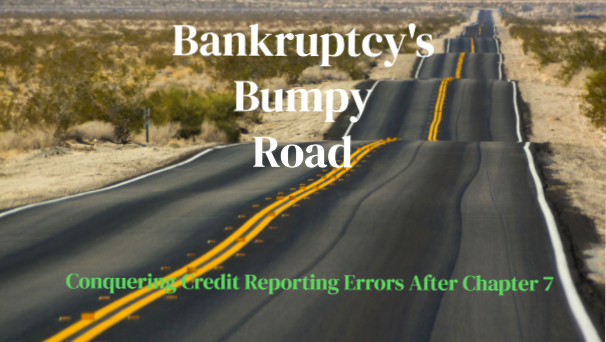Bankruptcy’s Bumpy Road: Conquering Credit Reporting Errors After Chapter 7
Post-Chapter 7 Bankruptcy Credit Reporting Errors: Protecting Your Rights and Your Fresh Start
Introduction
Chapter 7 bankruptcy is a legal process that can help consumers eliminate most of their unsecured debts, often within a short period of time – sometimes as quickly as 3 months. This type of bankruptcy is known as a “fresh start” bankruptcy, as it provides individuals with an opportunity to rebuild their financial lives. However, credit reporting errors following a bankruptcy are quite common and can negatively impact the fresh start that bankruptcy is intended to provide.
In this article, we’ll discuss the most common post-Chapter 7 bankruptcy credit reporting errors and how our law firm can help protect your rights and your fresh start.
Common Post-Chapter 7 Bankruptcy Credit Reporting Errors
1. Incorrect account status
- Discharged debts reporting: After a Chapter 7 bankruptcy, discharged debts should be reported as “included in bankruptcy” with a zero balance. This accurately reflects that the debt has been discharged and no longer owed by the consumer.
- Consequences of incorrect reporting: If creditors report these accounts with an incorrect status, such as still active or with an outstanding balance, it can have negative consequences on a consumer’s credit score. This may make it more difficult for the individual to obtain new credit, secure loans, or even rent an apartment.
- Impact on fresh start: The incorrect reporting of discharged debts can hinder the fresh start that bankruptcy is meant to provide. Consumers who have completed a bankruptcy should be able to rebuild their financial lives without the burden of past debts. By ensuring that discharged debts are accurately reported, consumers can move forward with confidence in their financial future.
- Addressing the issue: To better understand this issue and how to address it, read our article on common credit report errors and how to fix them. This resource will provide guidance on identifying and disputing incorrect account status reporting on your credit report.
2. Duplicate reporting of discharged debts
- Occurrence of duplicate entries: Sometimes, creditors and debt collectors might report the same discharged debt, resulting in duplicate entries on a consumer’s credit report. This can occur when both the original creditor and a debt collector or collection agency report the same debt as separate entries.
- Impact on credit scores: These duplicate entries can significantly impact credit scores by creating the appearance of multiple unpaid debts instead of just one. This can make it more difficult for consumers to obtain new credit, secure loans, or rent an apartment.
- Hindering the fresh start: Duplicate reporting of discharged debts can hinder the fresh start that bankruptcy is meant to provide. Consumers should be able to move forward with their financial lives without the burden of inaccurately reported debts. Disputing and correcting duplicate entries is crucial to ensure the accuracy of your credit report and maintain the benefits of your bankruptcy.
- Dispute process: It’s crucial to dispute such errors and ensure the accuracy of your credit report. Learn more about the dispute process for credit reporting errors. This resource will provide guidance on identifying and disputing duplicate entries on your credit report, helping you protect your fresh start after bankruptcy.
3. Re-aging of discharged debts
- Debt removal timeline: Discharged debts should be removed from a credit report after 7-10 years, depending on the type of debt. This is in accordance with the Fair Credit Reporting Act (FCRA) guidelines that dictate how long negative items can remain on a consumer’s credit report.
- Re-aging by creditors: However, some creditors might re-age debts, causing them to remain on a credit report longer than legally allowed. This practice involves updating the date of delinquency or last activity on the debt, effectively resetting the clock on when the debt should be removed from the credit report.
- Prolonging negative impact: Re-aging debts can prolong the negative impact on a consumer’s fresh start after bankruptcy, as their credit report will continue to show discharged debts that should have already been removed. This can make it more difficult for the individual to obtain new credit, secure loans, or rent an apartment.
- Addressing re-aged debts: For more information on how long negative items stay on a credit report and how to address re-aged debts, check out our guide on how long negative items stay on your credit report. This resource will provide guidance on identifying re-aged debts and disputing them to ensure the accuracy of your credit report after bankruptcy.
How Our Law Firm Can Help
Our law firm focuses on addressing credit reporting errors, including those related to Chapter 7 bankruptcy. We understand the complexities of disputing errors with credit reporting agencies and, if necessary, can pursue legal action on behalf of our clients.
We are committed to working exclusively for consumers, helping them protect their fresh start after bankruptcy by resolving credit reporting issues. By partnering with our experienced team, you can ensure that your rights are protected and that your credit report accurately reflects the outcome of your bankruptcy.
To get started, we encourage you to contact our law firm for a free consultation or case evaluation to discuss your post-Chapter 7 bankruptcy credit reporting errors.


